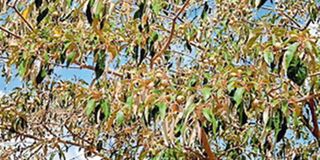Shunned tree that has huge biofuel potential

The Croton megalocarpus which grows naturally in various ecological zones. The leafy, multi-branched and fast-growing croton is one of the most profitable trees. FILE PHOTO | NATION MEDIA GROUP
What you need to know:
- Croton seeds do not require any pre-sowing preparation, according to the Seed Handbook of Kenya edited by Omondi W, Maua JO, and Gachathi, FN and published by the Kenya Forestry Research Institute.
- A key factor that a farmer should consider when choosing the type of tree to grow is its purpose, according to Kefri experts.
- The croton’s bark, seeds, roots and leaves are traditionally used to treat stomach ailments, malaria, wound clotting and pneumonia.
- When the oil is extracted, what remains is used as animal feed. Croton seed has high oil (30 per cent) and protein (50 per cent) content.
Croton megalocarpus grows naturally in various ecological zones — from the Coast to the highlands of central Kenya and the drylands of the North Rift.
It is called Msenefu in Kiswahili, Mukinduri in Gikuyu and Kelelwet in Kipsigis. In these regions, annual rainfalls ranges between 400mm and 1,400mm.
It is a drought-resistant tree that can survive in harsh climatic conditions and is a good wind breaker, hence its popularity on farm boundaries.
My experience with this tree since 2014, mostly in Soy, Eldoret, has taught me that it struggles in swampy areas because at a young age, it is easily affected by waterlogging.
Its scientific name comes from the Greek word kroton, which means tick. Its seeds resemble ticks.
Croton seeds do not require any pre-sowing preparation, according to the Seed Handbook of Kenya edited by Omondi W, Maua JO, and Gachathi, FN and published by the Kenya Forestry Research Institute.
If you are making your own nursery, sow the seeds in well-prepared beds and cover them with dry grass mulch.
Remove mulch immediately germination starts. It can also be sowed directly in pots. Germination takes 15-30 days. A kilo of the seeds at the Kefri Seed Centre, Muguga, costs Sh1,000. The tree can grow up to 35 metres tall and take 10 to 25 years to mature.
A key factor that a farmer should consider when choosing the type of tree to grow is its purpose, according to Kefri experts.
The species must fulfil the objective for planting it — like soil and water conservation, improvement of soil fertility (supply of mulching material and green manure), bee forage and animal fodder.
It should also provide saleable products such as medicine, fruits, nuts, fire wood, charcoal, fencing poles and timber.
The leafy, multi-branched and fast-growing croton ticks all these boxes, hence it is one of the most profitable trees. Its wood is termite-resistant, making it suitable for fence posts and in construction. Because of its many branches, it is sustainable as fuel wood.
The croton’s bark, seeds, roots and leaves are traditionally used to treat stomach ailments, malaria, wound clotting and pneumonia.
HUGE POTENTIAL
In One hundred years of solitude, a novel by Nobel Prize winner Gabriel Garcia Marquez, Fernanda gives a vial of this oil to Meme when she comes down with a serious stomach upset.
It gets even better. Increasingly, the seeds are being used as a source of biofuel, fertiliser and animal feed. This is where its potential to change the fortunes of farmers lies.
In Kenya, there is a company in Laikipia County that processes croton seeds into biofuel, fertiliser and seed cake for animals and poultry.
It sources seeds from agents who collect them from wild trees. The company buys at Sh10,000 a tonne. Farmers in this region can also grow the tree to supply the seeds to the company.
When the oil is extracted, what remains is used as animal feed. Croton seed has high oil (30 per cent) and protein (50 per cent) content.
The husks, which are rich in nitrogen, are used to make organic fertiliser. Leaves are also used as mulch because of their high nitrogen content. The oil is used in machines and in tanneries to treat leather.
Some cultural beliefs prevent croton from being planted close to homes with some communities believing it brings bad luck. This superstition is extant in many cultures. The Kikuyu, for example, believe the mugumo is a sacred tree just like the Tachoni with the omutoto.
But these beliefs can be devastating to farmers and their fortunes. Croton came into my life sometime in 1983. I was a Form Two student in boarding school.
One holiday period, I came home in Bungoma to find these trees had been planted in our compound. A number of other homes in our village had also planted them. In 1985, nearly three years after they were planted, the trees vanished.
Once again, I came home from school to find they had been uprooted. Not just in our home but in the other homes as well.
Why? An unsubstantiated rumour had spread about a man who had planted them in his home in the morning. Then in the evening, he died. Superstitious people blamed the tree for this ‘death’.
Up to today, not many farmers in the region grow the tree. Which is a big tragedy given the tree’s huge potential.



